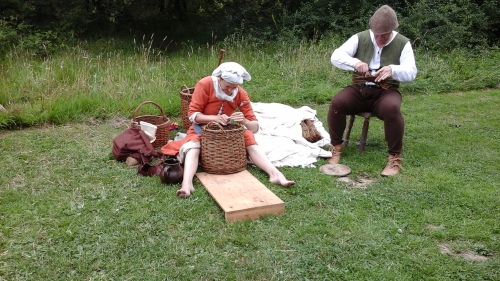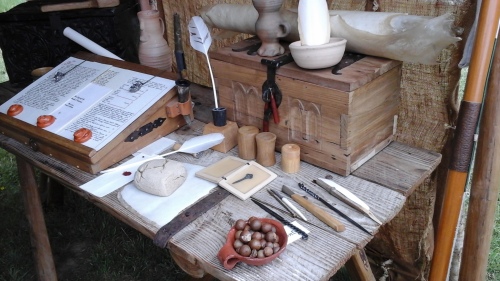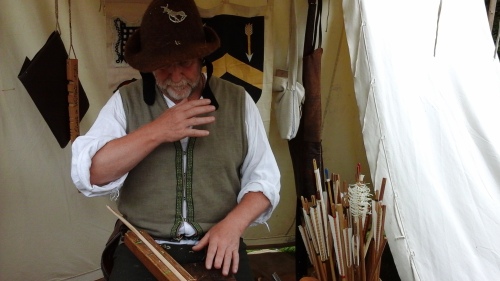
Melford Hys Companie
Last weekend there was a medieval event not far from where I live. It was put on to celebrate the official launch of the Virtual Museum of the Grace Dieu. The Grace Dieu was a huge ship built for Henry V. It made only one voyage before it was hit by lightning and sank in the River Hamble, near Southampton. The medieval event took place in the River Hamble Country Park, close to where the ship sank.

Basket weavers
There were two different groups of medieval re-enactors at the event. One group, the Medieval Free Company, represented a village where there was a leather worker, a fletcher, a woman who made herbal remedies, a scrivener and a basket weaver. Their period is the Wars of the Roses.
The other group was Melford Hys Companie, a group of players. The players doubled up by demonstrating medieval crafts as well as acting. The crafts were woodturning, felting, spinning and basket weaving.

Woodturner
On the woodturning front I learned that greenwood was used to make household objects, such as bowls, rather than dry wood. I’m sure the reason for this was explained, but I can’t remember it. I do remember that the wood warps as it dries, as you can see from the bowl on the end of the woodturner’s workbench.
One of the women in the group spins and I asked her some questions. I’ve never understood how spinning works and she was kind enough to explain it to me, whilst demonstrating. From her I learned that rich women did not spin. This was a bit of a blow, as I have a scene in my current work in progress where two very rich women sit down and spin together.
Another thing I learned was that, although medieval depictions of women spinning show them holding a spindle and a distaff at the same time, it’s perfectly possible to spin without a distaff. After the demonstration, I was allowed to have a go and enjoyed it. Later in the day I realised that the basket full of fleece, carding implements and spare spindles was intended for children, but I was very grateful to have had the chance to try. I was so engrossed in what the spinner was doing that I forgot to take a photograph, but I was very inspired by my lesson and bought a spindle so that I can carry on practising.

Handspun thread
To my great joy, pea pottage was on the menu for lunch for the players. You can see the peas and carrot and rosemary in the pot. There’s also onion, garlic and a bit of bacon in there. They were aiming for something fairly substantial and used marrowfat peas soaked overnight. Somebody had to sit and watch the pot all the time to make sure that the fire didn’t go out and that the pottage didn’t get too dry. It was quite windy, so there was a constant danger of the sparks setting fire to something.

Pea pottage
The pottage must have done the job, because it all disappeared and I saw the pot watcher doing the washing up in the pot after lunch. Another lesson learned – pots are expensive and can be dual purpose.
Two of the women were working on felting projects. One was for children. The other, most decidedly, was not.

Felt bosoms for the actors
The bosoms are to enable the male actors to look the part when they have to play female roles.
I only saw part of the felting process, but a rough pattern was made from a piece of linen cloth and the fleece placed on both sides of it. The wool was made wet and soaped. It was placed on a board and the woman making the prop had to keep rubbing it so that the fibres stuck together and shrank. The finished object was quite a bit smaller than the pattern.
On the right of the photograph you can see the knife with which she shaved off pieces of soap into the mug of water.
In the other camp there was a scrivener, who explained about how ink was made with ground oak apples, coperas (ferrous sulphate) and gum. On his table you can see cuttlefish for drying the ink on the page; a triple baked loaf of bread for polishing parchment; and a wax tablet for a learner writer. You can also see a part of his bow, as all men were supposed to know how to shoot.

Scrivener’s Table
If you look carefully on his writing desk, you’ll see a printed pamphlet and he’s writing on paper. Paper was used in the fourteenth century, but printing had not been invented.

Leather worker’s tent
The leather worker made sheaths for swords and daggers, as well as belts, flasks and pouches. Whilst his leather and some of his goods were arranged tidily, you can see that he was rather careless with his armour.
There was also a fletcher in the Wars of the Roses village. He demonstrated how arrows could be made to fit individuals, but the majority of arrows which went to France with archers were not made to order. They were made in what were essentially factories, churning out arrows for the English armies. As the fletcher explained, you did not have to be a particularly good archer, or have made-to-measure arrows, to succeed in a battle. An enemy army provided quite a large target and any arrow fired in its general direction would probably hit something. He also said that, in his younger days, he could let off a further two arrows before his first had landed, which goes some way to explaining why Welsh and English archers were so successful and so feared.
I was surprised by the different types of points I saw on the arrows. One looked like a fork and another like a knife. One had a very vicious-looking barb on it.

Fletcher
I had a very enjoyable day out with the re-enactors. It is one thing to read about how something is done, and another to see it being done. Best of all, I’ve got an inkling of an idea about a novel from it.



I love the idea of these events!
My friend is into Anglo Saxons and often goes to dressing up and acting out events!!!
LikeLiked by 1 person
They were clearly having a good time. I think I’d get bored explaining things for the millionth time. I’d also be terrified by what the children would do. One little girl almost had her brother’s eye out with a sword because her dad wasn’t paying enough attention.
LikeLike
Oh man
LikeLiked by 1 person
What a fun way to learn skills from years past. Saw a program the other day about this group of sweet makers that are participating in a challenge to make medieval sweets and deserts etc. They mentioned how sugar was an expensive commodity, and I thought of your blog post 🙂
LikeLiked by 1 person
That definitely sounds like a programme I would have enjoyed.
It was a fun event. I’d like to track down another one before the end of the summer.
LikeLiked by 1 person
I think it was on ITV, it was a recorded program. As we only watch the news on TV.
LikeLiked by 1 person
If it’s the same one that someone else mentioned this morning, it was on BBC 2. I’m going to have a look later this afternoon.
LikeLiked by 1 person
It must probably is, we aren’t that familiar with the all the channels 🙂
LikeLiked by 1 person
I’m halfway through it. It’s good, but I’m glad I didn’t have to go to all that fuss to get a bit of sugar.
LikeLike
Agreed! 🙂
LikeLiked by 1 person
That pea pottage looks good. After I’d read your earlier post about pottage, I recalled hearing a woman mention that, during the 1930’s Depression, her mother was making soup with a few vegetables when their cat brought in a starling. That also went into the soup! I now wonder if small birds were used to flavour pottage.
It’s great talking to re-enactors. When I was in England in April I went to the Bank Holiday Weekend Fair at the Weald & Downland Museum, and also to a Medieval Market at Midhurst. Some fascinating demonstrations and conversations.
LikeLiked by 1 person
I expect small birds did go into the pot, or anything else that might have added some flavour. There are pictures of peasants using nets to trap small birds.
The W&D isn’t that far away. Neither is Midhurst. I shall have an eye open for next year. I did think about going to Chalke Valley, which is a big history festival in Wiltshire, but it’s more than medieval.
LikeLiked by 1 person
It sounds like such a great event. I love the Pea Pottage too, might have a go at this for dinner one night – probably not quite the same when not cooked over a fire though 😉
LikeLiked by 1 person
The one I made was fine, but slower cooking would probably make a difference.
LikeLiked by 1 person
I went to one of these, as an observer, when I was in college but it was mainly warfare and battle focused. Very little in the way of crafts. I enjoyed this little tour.
LikeLiked by 1 person
Thank you, Dan. It was a very small event, but the Wars of the Roses village was quite war focused.
LikeLiked by 1 person
I love how you felt so engrossed in the spinning process you forgot to take pictures! What a wonderful way to experience Medieval life! I can tell you got a lot out of the experience, both as an enjoyment and for your research. Thanks for sharing!
LikeLiked by 1 person
My pleasure, Angela. It was a lot of fun.
LikeLike
This was such an informative post April. I felt for you finding an error in your book though – rich women didn’t spin. I’ve never attended anything like tis in Australia, although years ago we went to a theme park which had a mock medieval castle and we watched a jousting tournament. I felt sorry for the horses. See arrows being made and all the other crafts would have been fascinating. I find it hard to imagine the amount of clothes they wore, the impracticality of them and the challenge cleaning them would have been presented. Thank goodness for modern t shirts!
LikeLiked by 1 person
Thanks Robyn. I think the revelation to me about the clothing is that they were made from natural fibres, so they breathed. Woollen clothes were a problem when they got wet, because they took forever to dry.
I’d love to see a joust. There are events across the country at this time of year, especially now that the schools are on holiday, so I shall probably be able to find one.
LikeLiked by 1 person
Exciting. And I wasn’t prepared for the sound of the jousting pole hitting the shield/armour. The jolt was phenomenal
LikeLiked by 1 person
I never would have guessed that ink was made out of ground oak apples, coperas (ferrous sulphate) and gum. That’s very interesting.
LikeLiked by 1 person
It is and I really want to know what made someone think of trying that particular combination I can understand the oak apple and gum bit, but it’s the coperas. which confuses me.
LikeLike
What a great read! Really inspires me to want to find one near me to visit!
LikeLiked by 1 person
Thank you. It was great fun. It was only a small event, but there was a lot to see.
LikeLiked by 1 person
Excellent – really enjoyed that. Shame about the spinning; I suppose you couldn’t have your two ladies chatting while they had their nails done? 🙂 Bernard Cornwell says quite a bit about archers and archery in his medieval novels. Bodkin arrows had no barb and were designed to penetrate armour; barbed arrows, clearly, were designed to inflict enormous wounds.
LikeLiked by 1 person
Thank you. I’ve got a tentative solution for the spinning women.
In my mind I had an idea of what a barbed arrow was like, but I wasn’t at all prepared for the size of it. If Henry V got one of those in his face, I’m not surprised he only showed one side in his portraits. There can’t have been much left of the other side.
LikeLike
Is that what happened to him? I had no idea!
LikeLike
At the battle of Shrewsbury. Apparently, quite a few people had a go at getting it out before someone who knew what they were doing sorted it out.
LikeLike
Thank you for this interesting post, April! As you may already know, I belong to a medieval reenactment group called the Society for Creative Anachronism, which is organized in ‘kingdoms’ that practically span the globe, although the group as a whole was originally founded in California in the 70’s when a wedding couple decided that their nuptials would take place in as authentic a medieval setting as they could make it. Great strides have been made since then.
Many people think of the SCA only in terms of the martial tournaments that are a regular feature of our events, but equally important is the division called A&S, Arts and Sciences, in which the activities you describe here would fall. September will mark my one-year anniversary in the group, and I have been learning so much: sewing, period embroidery and archery, to name a few things. I’ve also taught classes on Women in the Viking Age. To top it off, it’s just so much fun! I encourage people everywhere to go to these types of events!
LikeLiked by 1 person
Thanks, Timi. I’ve found a couple during August that I might be able to get to.
LikeLike
Pingback: Spinning | A Writer's Perspective